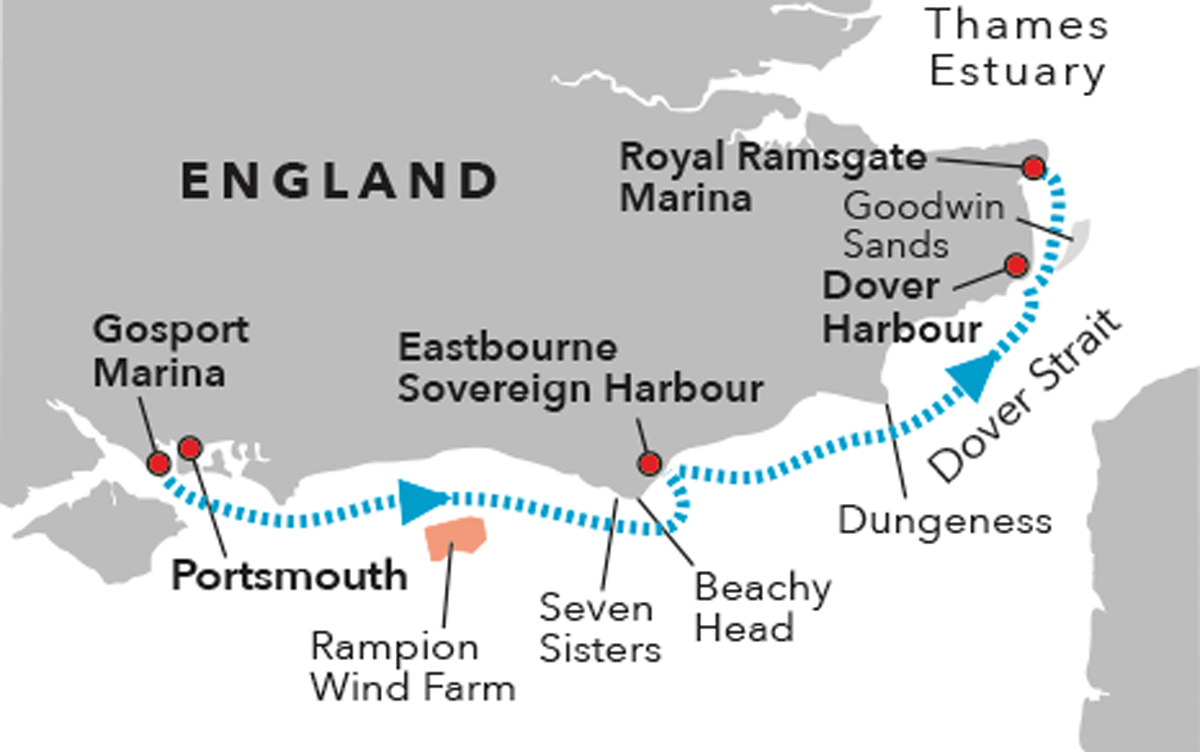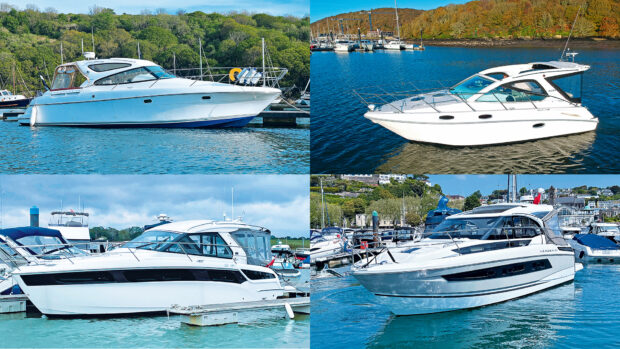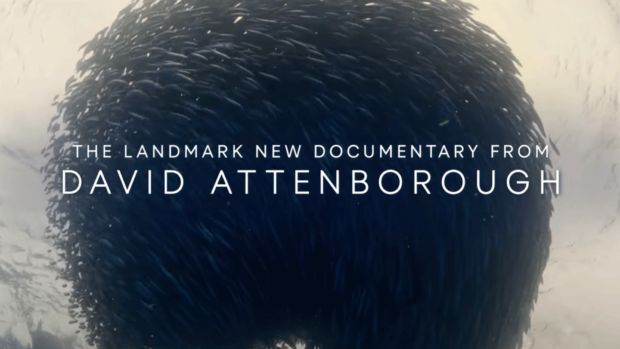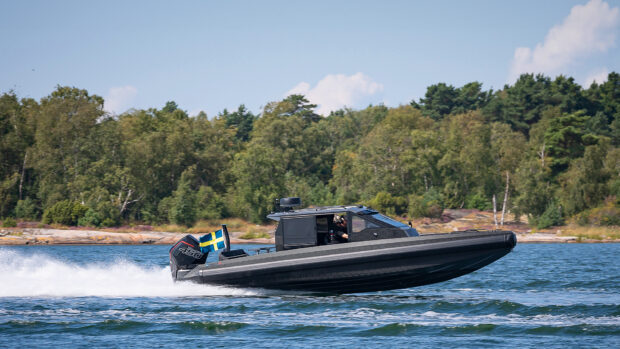Rhea 850 Timonier owner Philip Davies sets off from Gosport Marina on an ambitious cruise around the British mainland
I’ve been motorboating for 30 years and during that time have owned, in chronological order, a Princess 45 (10 years), a Trader 535 Signature (10 years), an Island Packet SP Cruiser (3 years) and a Fairline Squadron 42 (5 years).
I have cruised extensively both sides of the English Channel, the Spanish Costas and the Balearics. So why did I choose to undertake my biggest nautical challenge yet, a complete circumnavigation of Great Britain, in the smallest motorboat I’ve ever owned?
Perhaps it was the confidence I had in the sea-keeping of the pretty little Rhea 850 Timonier I had recently downsized to. Perhaps it was to prove that ambitious boating is not the exclusive domain of larger motor cruisers.

Philip’s sturdy Rhea 850 Timonier Start Me Up
Perhaps it was a 67-year-old trying to convince himself he could still act and think like a man 30 years younger. Or perhaps it was simply because it was there to be achieved. What is certain is that it was never on my ‘bucket list’ of things to do, so perhaps I’d better explain how it came about.
Late last year I was being given a lift home from our local pub by my 27-year-old godson, Charlie Boutwood, and his father Nigel. They came in for a nightcap. Nigel, who is a rag-and-stick man, informed me that they would not be participating in the Round the Island Race in 2019.
He had sailed in 14 consecutive races around the Isle of Wight to raise money for Charlie’s Challenge, a children’s brain tumour research charity he had founded with his wife, and which I had been a trustee of from the outset.
Article continues below…

Secret South Coast cruising: Discovering the hidden gems of Sussex and Kent

VIDEO: Rhéa 730 Timonier review
Honest, charming and brimming with French flair, the Rhéa 730 Timonier proves a trusty companion in a rough Solent sea
Charlie had survived such a tumour as a 20-month-old child and was the inspiration for the charity. I was ‘over refreshed’ at the time and said “why didn’t we go round a proper island… Great Britain, in my new boat, Start Me Up?”
The following day Nigel phoned to ask if I meant it. Not wanting to admit that it might have been the beer talking, I said that I did. Then he asked if that meant going right around the top of Scotland or the softer option of cutting through the Caledonian Canal, again I responded that we were going to do it properly or not at all.
From that moment on I went to sleep every night thinking about going around the top of Scotland and woke up every morning thinking about going around the top of Scotland until eventually we did go around the top of Scotland!

The planning begins
The first thing to decide was which way round to go. Having made a dozen or so trips down to Devon and Cornwall from the Solent in my boating career and been held up on more than one occasion by the prevailing south-westerlies, I felt that we should head east and go around Britain in an anti-clockwise direction.
However, I did read the blogs of the most recent circumnavigators, two sailors (one solo, the other crewed) who went clockwise from the Solent and one motor boater, who went anticlockwise from Falmouth. I also looked up the question on Google and found long and detailed arguments for both cases.
To me it just seemed logical that the prevailing south-westerlies would deliver a more comfortable following sea state along the south coast to Ramsgate and would hopefully continue to blow offshore on the east coast giving slight seas, then become more southerly and therefore still following us as we headed up the North Sea.

The same weather system might even deliver south-easterlies and easterlies at the top end of Scotland and north-easterlies and northerlies down the west coast of Scotland with the constantly hoped for benign sea states.
Logic further dictated that we hugged the east coast of Ireland rather than the exposed west coast of England and Wales to gain further protection from the prevailing westerlies/south-westerlies. From southern Ireland across to south-west Wales we would have to rely upon the weather Gods, against prevailing weather, to deliver comfortable sea conditions to cross the Bristol Channel and eventually round Land’s End.
We were originally intending to start our adventure on the 1st April 2019, April Fools’ Day, in the hope that we would be around the top of Scotland by early June at the latest. The assumption was that at some point we would be held up by unsettled weather and this would give us the time to be patient and wait for the right combination of tide and wind before pressing on.

Start Me Up may only be 27ft long but it punches well above its weight
Considering how cold it was in Scotland by the time we eventually got there in late May, I was very pleased we didn’t get going until May 17 and not earlier as originally planned.
One of the clockwise sailing blogs I had read started much later, ending up rounding the top of Scotland very late in the summer/early autumn causing uncomfortable conditions and questionable decisions. He concluded his blog by saying he would have gone sooner and anticlockwise to avoid this with hindsight. So, anticlockwise it was, with the plan to get around the top of Scotland ASAP!
Magna charter
I went to Gosport Marina (where the boat is kept) from our home in East Sussex. I wanted to check out the various systems and source the other bits and bobs that we might need going around Great Britain but weren’t previously necessary when simply pottering around the Solent.
The charts in the plotter only covered the English Channel, for instance, so I upgraded to the whole of the British Isles. For some reason these also included the entire European Atlantic coast and the Western Mediterranean. Garmin only does this huge area rather than just the British Isles.
The sales guy told me I just had to take out the existing card and load up the new one. Simple, or was it? When I loaded the new card the image was at 90° to the north and the autopilot was 40° out. Apparently, even though my plotter was only one year old it needed a ‘simple’ operating software upgrade that should fix the problems. Just to be safe I also ordered 17 Imray ‘C’ series paper charts for passage planning and back up.

Philip and Nigel set off from Gosport at the start of their big adventure
The engines, twin 220hp Volvo D3s, had their first service and whilst I was at it I bought a complete set of additional service parts in case they were needed en route.
I’d bought the 2019 Reeds Almanac as soon as it was available before Christmas 2018, and had spent two days researching which harbours we would call into as a basic passage plan. There were two essential requirements, fuel and 24-hour access. There was only one compromise – calling into Grimsby, which had a lock and access restrictions but where there was no better choice on that stretch of the east coast of England.
Then I read about the passage from Wick at the top right-hand corner of Scotland around the top, but not before we had got through the dreaded Pentland Firth, an eight by five-mile nautical nightmare of 12-knot races that awaits you when you make that top left-hand turn. This only seemed to amplify my mounting dread of this part of our voyage.
I had the boat lifted for a bottom scrub and hose down at Premier Marinas Port Solent, then purchased industrial quantities of Mini Cheddars, Kettle Chips, Twix, bottled water and beers for the crew. It’s just as important to keep the crew fully fuelled as it is the boat.
Gosport to Eastbourne
I had been looking at the weather for a suitable window of opportunity to kick the project into life. I had also been taking note of the sea forecasts, particularly at the very top of Scotland, every day since we had committed to undertaking the trip. For months I had only seen Force 5s and upwards, always accompanied by Rough to Very Rough and frequently High to Phenomenal. Gulp.
Finally, there was a big high-pressure weather system settling over the whole of the UK, it was blindingly obvious that we should take advantage of it and see how far we could get up the east coast of England.

Passing the vast Rampion wind farm en route to Eastbourne
Our friend Peter took us to Gosport marina and at 2pm on the dot, seven months after we first floated the idea, we fired up the engines and off we went. We couldn’t quite believe this was the beginning of a 2,000-mile journey around Great Britain in our little motorboat – we must be completely mad.
Our course took us via the Outer Owers Buoy and directly along the coast to Eastbourne, passing the massive Rampion Wind Farm, which produces enough energy for 350,000 East Sussex homes. A little later on we passed the magnificent Seven Sisters and then Beachy Head itself.
Surreal send off
When we reached the entrance to Sovereign Harbour, we couldn’t get an answer on Channel 80 but as the lock gates were open and the lights on green for another boat ahead of us, we just followed her in.

Passing Eastbourne’s once-lavish pier
When I asked the berth master why they weren’t listening on Channel 80, his reply was brief and to the point. “Because we listen on Channel 17!” Note to self: consult your 2019 Reeds Almanac more thoroughly and don’t make any assumptions about anything!
We were allocated a lovely berth with more than enough pontoon space to host a little leaving party on Sunday 19 May for our local friends, this particular marina being located only 12 miles from our home.
At the appointed hour a suitable number of bemused friends turned up to enjoy a glass or two of Black Dog Hill 2013 Classic Cuvée, an award-winning English sparkling wine, and send us on our way.
We entered the lock at 1500hrs and departed to the cheery goodbyes of friends and family, setting our course for Dungeness. The plotter was still 90° out but I still had a compass and a chart, and the visibility was excellent, even if the seas were a little choppy.

Ramsgate was the crew’s final stop before they tackled the east coast
We coast hopped from headland to headland until we passed Dover Harbour and took our first significant turn to port on the final leg to Ramsgate, avoiding the infamous Goodwin sands to starboard.
Having read Reed’s entry for Ramsgate we were able to call Channel 14 for permission to enter (granted) and then Channel 80 (correctly, this time) to be allocated a berth. We were offered a choice of 20 different fingers on Pontoon F. We took our pick, hosed the boat down and tidied up for our first visitor, Nigel’s sister Janie.
We had covered the 60 miles to Ramsgate in 3 hours 30 minutes, from lock to pontoon finger and were feeling pretty smug about things. Something told me things were going to get a bit tougher on our route up the east coast but for now we were going to enjoy our early successes with (another) celebratory drink or two!
Next month: Philip and Nigel enter the North Sea proper as they continue their intrepid adventure…









